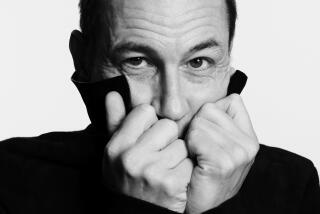‘Red River’ Makes a Man of John Wayne
- Share via
As did many of my generation, I spent several years eyeing John Wayne with suspicion. A lot of it had to do with his right-wing politics, but the acting didn’t help. Wayne always came across as kind of a Victor Mature on horseback, a star that was all hat and no cattle.
My perception changed later, especially after giving myself over to such movies as “The Searchers” and “Red River.” Both John Ford, who directed “The Searchers,” and Howard Hawks, the director of “Red River,” used Wayne like a natural phenomenon, as visually iconographic as the Western landscape they cherished. With their help, Wayne became a national monument to manliness.
That didn’t mean he was a great actor. Wayne never had much reach, but his performances were usually clean, direct extensions of what his better directors were trying to convey. In “Red River” (screening at Cal State Fullerton on Wednesday night with Sam Peckinpah’s “The Wild Bunch”), Wayne is the can-do American spirit tainted by megalomania: As Tom Dunson, he’s a man’s man but also a therapist’s man, a big dude with a big heart, big ego and big hang-ups.
The 1948 movie begins both majestically and tragically. Dunson stands out against the desert valley landscape and tells the leader of the wagon train that he’s going it alone. His girlfriend (Coleen Gray) says he’s wrong, but that doesn’t stop him.
When the pioneers are slaughtered by Indians, a massacre Dunson may have prevented, we realize she was right. It’s not Dunson’s last mistake; Hawks and screenwriters Borden Chase and Charles Schnee make a theme out of his fallibility.
It’s never clearer than in his relationship with Matt (Montgomery Clift), the young man Dunson adopts. From the scene in which Dunson finds Matt wandering through the desert shortly after the battle, Hawks jumps ahead 15 years. Dunson, with Matt and Groot (Walter Brennan) at his side, now owns a cattle empire on a stretch of land near the Rio Grande he calls Red River.
The movie’s tension surrounds Dunson’s cattle drive to Missouri, a hard journey that brings out the worst in Dunson and the best in Matt. Their separation, conflicts and heroic final meeting give “Red River” a rough-hewn human drama. What matters most: love or macho honor? Dunson has to figure it out.
The look of “Red River” is spectacular, in great part because of cinematographer Russell Harlan. As with Ford, environment becomes as significant as character to Hawks; in fact, it describes the essence of his characters. What makes the terrain great is its uncompromising integrity. Dunson may be troubled, but he’s also as unintimidated as the cliffs and valleys around him.
Although Dunson seems made for Wayne, Matt must have presented quite a challenge to Clift. The actor doesn’t look right in cowboy duds; his air of pretty-boy vanity hangs over him like a noose. But the quietness of his performance wins out in the end, and the role helped launch his career. Teen-age girls were quick to swoon over Clift in boots and chaps, and a matinee idol was born.
More to Read
Only good movies
Get the Indie Focus newsletter, Mark Olsen's weekly guide to the world of cinema.
You may occasionally receive promotional content from the Los Angeles Times.








